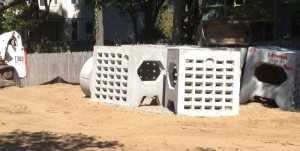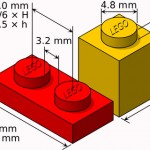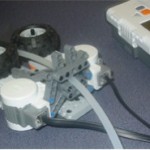
Engineering is a design process, combining knowledge of the properties of materials, models that predict how these behave, and innovative thinking, to create often-novel solutions to human needs.
In contrast, it may be helpful to think of technology as the process of making things, using tools, materials, and process skills to bring into physical reality the plans of engineers (as well as those of other design professionals such as artists and architects).
Three interconnected examples illustrate this:
- A building owner or architect requests the design of a new office building to include a rain garden that will return rainwater drained off the roof to the soil. A civil engineer would design the system, taking into account the volume of water per hour generated by a typical rainstorm, the porosity of the soil, and any obstructions in the soil. Once the city engineer approved the design, the system would be constructed by technologists that include a backhoe operator, landscapers, gardeners, suppliers of prefabricated drainage concrete boxes, and paving installers.
- For the same building, an electrical power systems engineer designs the power distribution system taking into account the expected electrical loads, the capacity of given sizes of wire, the number of circuits required, and the electrical mains available (perhaps even including solar panels).A technologist (an electrician or electrical contractor) would physically construct the designed system, while other technicians in factories would fabricate the supplied materials such as wire, pipe, circuit breakers, and solar panels.
- The tenant in the new building, a robotics company, is planning on marketing a new type of robotic floor cleaner to wash kitchen floors. A team of mechanical, electronic, and software engineers design the new machine, including its physical frame, gears and motors; its circuitry; and its program. The completed design is sent to a fabrication facility in Shenzen, China where expert technologists on electronic and plastics assembly lines mass-produce the design for shipment to customers.
For many challenges, the scientist or engineer, and the technologist, may be the same person. Even for the theoretician, a consummate knowledge of fabrication techniques is highly important. One of the hallmarks of the current maker movement is that these functions are integrated, giving the maker a sense of ownership.
It is also interesting to note that the motto of the Massachusetts Institute of Technology (MIT) is Mens et Manus – “Mind and Hand”, representing both the pursuit of theory and the practical arts of technology.
See also What is engineering? and What is technology?
Jonathan Dietz
Latest posts by Jonathan Dietz (see all)
- Challenges in K-12 engineering education: Lessons from Massachusetts - 18 January 2015
- What is the difference between engineering and technology? - 18 November 2014
- What is technology? - 11 November 2014
- What is engineering? - 6 November 2014
- Learning Dimensions: Another way to assess - 6 November 2014


